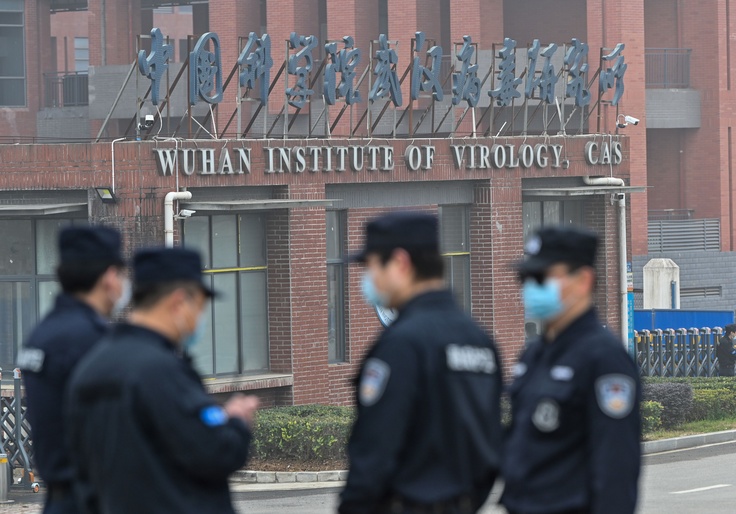COVID-19 most likely emerged from a Chinese lab, according to a report from Florida senator Marco Rubio (R.) obtained by the Washington Free Beacon.
The 328-page report details how systemic negligence from scientists and pressure from Chinese Communist Party officials left the Wuhan Institute of Virology uniquely susceptible to a lab leak. Rubio also reports that senior Chinese Communist Party officials were aware of a "serious biocontainment failure or accident" at the Wuhan Institute more than a month before disclosing it to the public, but worked to hide that information from outside observers.
"Just as Beijing was dismissing the lab leak theory of the origin of COVID-19 in international settings, internally, Beijing was warning its officials that the risk of laboratory-acquired infections with SARS-CoV-2 was significant," the report states.
Rubio's report is the latest evidence that COVID-19 emerged from the Wuhan lab. While public health officials early in the pandemic dismissed the "lab leak" theory as a conspiracy, a growing number of virologists and federal officials have concluded that the virus was man-made. The Department of Energy and the FBI have each released reports corroborating the lab leak theory, and Dr. Anthony Fauci—an early critic of the theory—said last December that he initially dismissed the lab leak theory out of fear of increasing "tensions" with China.
Rubio's report was compiled over two years and is based on a tranche of information, including an array of Chinese-language sources never before translated into English. The document tells a story of China's reckless push for biotechnology dominance and the CCP's fight to conceal the humiliating missteps that led to the deadliest pandemic in nearly a century.
The state-run Wuhan Institute of Virology is an integral part of the Chinese Communist Party's broader biotechnology strategy, which aims to modernize China's economy. Chinese Communist Party chairman Xi Jinping's five-year-plan "seeks to establish China as the global leader in biotechnology, particularly synthetic biology," the report states.
Those goals put tremendous top-down pressure on labs such as the Wuhan Institute, which received a deluge of government funding and attention from state media over the past decade. The Wuhan Institute cut corners in its laboratory safety protocol as it raced to keep up with its Western counterparts, all the while obsessively reducing its reliance on "key and core equipment" manufactured abroad.
The Chinese government in 2018 allocated funding for the Wuhan Institute to study two unspecified coronaviruses. Beijing has long taken an interest in these pathogens, both because they are prevalent in the nation and because, the report states, its military is concerned adversaries could develop bioweapons that spread them.
Although the report does not cite a specific incident that caused COVID-19 to escape from the Wuhan Institute, the lab's myriad safety issues were well known in the Chinese scientific community. According to the report, as early as 2017 Chinese scientists were "worried about 'pathogens escaping' in light of China's history of laboratory leaks, particularly several incidents involving SARS-CoV-1," and cited at least five coronavirus lab leaks in 2004.
Xi warned Chinese Communist Party officials in 2018 to be on the lookout for a SARS-like virus, although a summary of the speech published by state media omitted that portion of the Chinese leader's remarks, the report states. Shortly thereafter, American diplomats visited the Wuhan Institute of Virology and reported safety concerns back home.
Reports of safety issues at the Wuhan Institute of Virology persisted until September 2019, when the lab deleted its online database of viruses. The database was made briefly available to the public from December 2019 to February 2020, the same time "claims began to circulate on the Chinese internet alleging that the [Wuhan Institute of Virology] was the origin of SARS-COV-2 outbreak," the report states.
In September and October of that year, Wuhan saw a spike in hospital traffic. Anecdotal accounts, according to the report, suggest the hospitalizations were due to a coronavirus.
"Awareness of a laboratory incident seemed to have shaped the CCP leadership's response to SARS-CoV-2: a response characterized by strict controls of information, obfuscation, misdirection, punishment of whistleblowers, and the destruction of key clinical evidence," the report reads.
Two months before China acknowledged the existence of COVID-19 in December 2019, the Wuhan Institute of Virology held training on "conducting experiments." In January 2020, the lab met again to discuss safety, security, and record-keeping, the report states.
Once the international community was made aware of the virus, the report states, Beijing began an international deception campaign to deflect responsibility. Chinese Communist Party officials said in January 2020 that the virus emerged from a Wuhan wet market and ignored Chinese researchers who ruled out that possibility.
Beijing then imposed a gag order against all scientists, which forbade them from sharing any research related to COVID-19 all while denying to other governments that human-to-human transmission was possible. By February 2020, Chinese scientists affiliated with the government had filed a patent for a COVID-19 vaccine.
